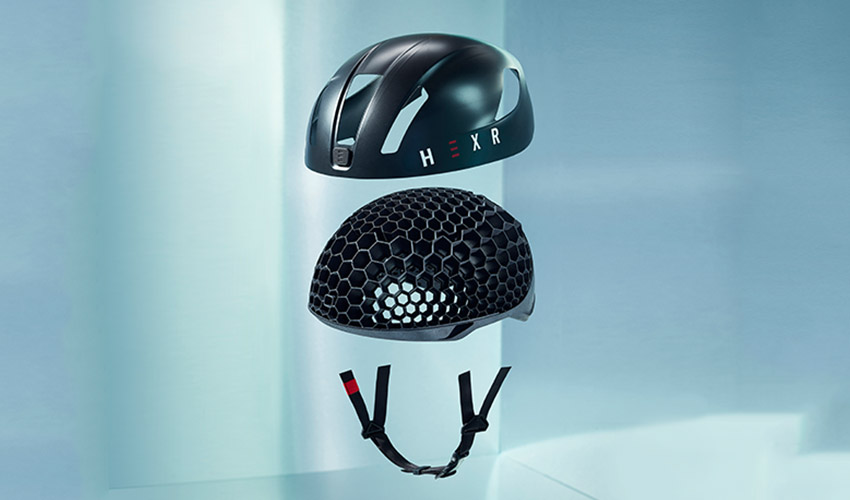HEXR creates safer 3D printed helmets

Helmets as we know them might not be the most efficient at absorbing shock. This is the realization Jamie Cook had when he started investigating materials and structures with leading material scientist, Prof Mark Miodownik at University College London (UCL). It soon became evident that cellular structures had the highest crush strength to weight ratio – a property perfect for helmets, which need to be both safe and lightweight.
In general, the average helmet relies on foam to absorb shock. Jamie Cook explains: “Foam’s pressure response is limited. There are only a few variables to play with: it’s quite basic in that sense. We’re 60 years down the road with foam helmets – and even though they’re only 30% efficient at absorbing energy, we’ve pretty much done everything we can do.” This is what led him to launch HEXR, a new type of helmet made from Polyamide 11 (PA 11) and 3D printed! He adds: “With 3D printing we’re starting on a new road which has got incredible opportunities for further optimisation, design and change. What we’re developing now is a real synergy between material science, manufacturing and technology – coming together to unlock things that were never possible before.”

Credits: HEXR
3D printing a safer helmet
The helmet industry has been relying on foam for a long time. However, as stated by Jamie Cook the foam market hasn’t progressed much in the last decades. This also explains initiatives such as EOS’ to bring new capabilities to foam by merging it with 3D printing. For example, the manufacturer is working on its Digital Foam program to enable applications such as 3D printed protective headgear, individualized orthotics, and performance footwear using this material.
Nevertheless, the HEXR founder didn’t believe this was the best material to work with whether 3D printed or not. As proof of concept, the company compared their PA 11 helmets with other bicycle helmets. The testing method simulated real life accidents at 22 km/h – the result: HEXR is 26% safer than traditional foam helmets.

Credits: HEXR
From a design perspective, the HEXR helmet is completely unique: “Every design method for energy absorption assumes that the contact area is constant – but that’s not the case for a curved surface. We need to design for the head’s unique curvature. The only way to make a curved honeycomb structure without distorting the mechanical properties is by 3D printing.” Essentially, by creating a structure made up of hexagonal cells in a honeycomb structure, it allows the shock to be dissipated across a larger area and prevent a serious injury. Moreover, the design can be adjusted to any head thanks to 3D scanning.
Finally, HEXR are continuing their research to produce the safest helmet and also one that is environmentally friendly. PA 11 is a 100% renewable raw material produced from castor oil. You can find more information on the website HERE.
What do you think of this 3D printed helmet? Let us know in a comment below or on our Facebook and Twitter pages! Sign up for our free weekly Newsletter, all the latest news in 3D printing straight to your inbox!






